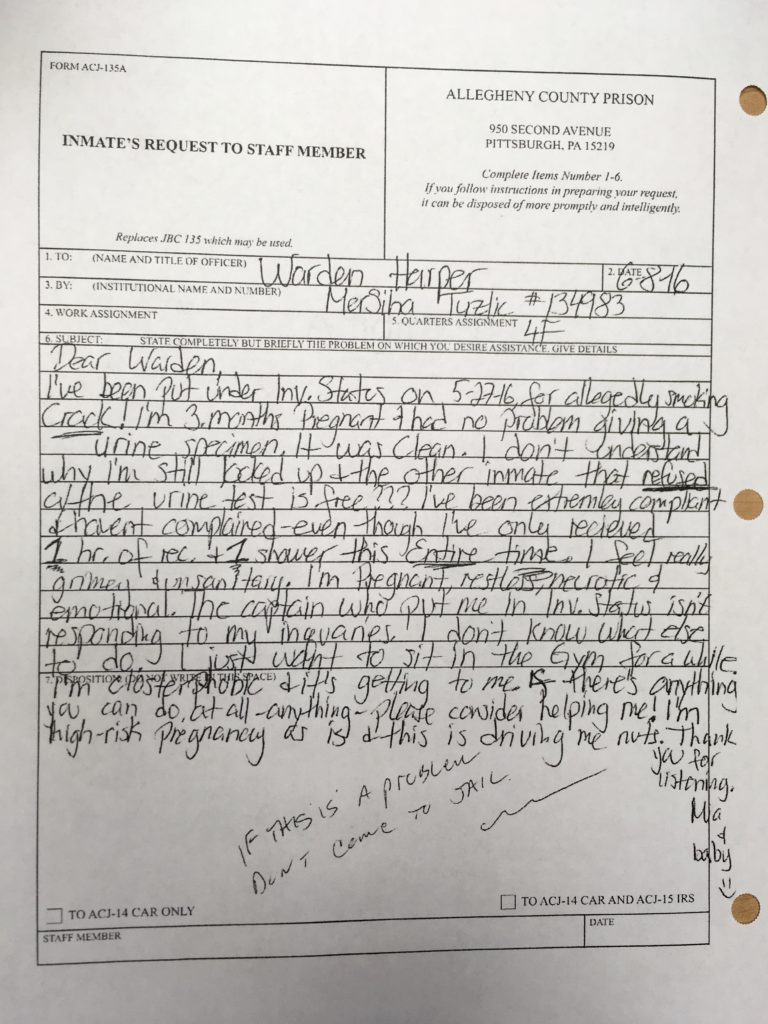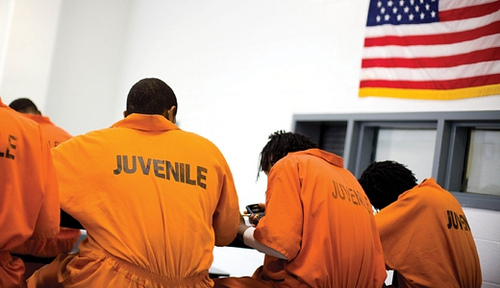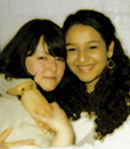
“The system here, is rigid, strict, and hopeless solitary confinement. I believe it, in its effects, to be cruel and wrong.” Charles Dickens
Allegheny County Jail, in Pittsburgh, Pennsylvania, routinely throws pregnant women into solitary confinement, for days on end, for minor offenses and less. Five women – Elizabeth Seitz, Mersiha Tuzlic, Riva Depasse, Jill Hendricks, Kiari Day – have refused to accept the injustice and indignity. Yesterday, December 19, their attorneys went to Federal Court to sue the Allegheny County Jail. This is Mersiha Tuzlic’s story, and it’s happening in jails across the country.
On May 27, 2016, Mersiha Tuzlic, was thrown into solitary. On June 18, she wrote a handwritten request to the warden, Orlando Harper, dated 6 -18 -16, which reads:
“Dear Warden,
I’ve been put under Inv. Status on 5-27-16 for allegedly smoking crack! I’m 3 months pregnant and hand no problem giving a urine specimen. It was clean. I don’t understand why I’m still locked up and the other inmate that refused the urine test is free??? I’ve been extremely compliant and haven’t complained – even though I’ve only received 1 hour of rec and 1 shower this Entire time. I feel really grimy and unsanitary. I’m pregnant, restless, neurotic and emotional. The captain who put me in inv status isn’t responding to my inquiries. I don’t know what else to do. I just want to sit in the gym for a while. I’m claustrophobic, and it’s getting to me. If there’s anything you can do at all — anything — please consider helping me! I’m high-risk pregnancy as is, and this is driving me nuts. Thank you for listening.
Ma and baby 🙂 “
The Warden responded to the plea for help: “IF THIS IS A PROBLEM, DON’T COME TO JAIL”
Welcome to the Commonwealth of Petty Dictators, where throwing pregnant women into solitary confinement for no reason at all isn’t enough of an assault on their dignity. When they ask for help, find ways to further diminish them. Show these women how really powerful you are. The god of small things battles the devil of small men, and in Allegheny County, for too long, the devil has been winning.
In 1842, Charles Dickens visited Pennsylvania, saw the new system of solitary confinement, and called it out: “Very few … are capable of estimating the immense amount of torture and agony which this dreadful punishment, prolonged for years, inflicts upon the sufferers; and in guessing at it myself, and in reasoning from what I have seen written upon their faces, and what to my certain knowledge they feel within, I am only the more convinced that there is a depth of terrible endurance in it which none but the sufferers themselves can fathom, and which no man has a right to inflict upon his fellow-creature. I hold this slow and daily tampering with the mysteries of the brain, to be immeasurably worse than any torture of the body: and because its ghastly signs and tokens are not so palpable to the eye and sense of touch as scars upon the flesh; because its wounds are not upon the surface, and it extorts few cries that human ears can hear; therefore I the more denounce it, as a secret punishment which slumbering humanity is not roused up to stay. I hesitated once, debating with myself, whether, if I had the power of saying ‘Yes’ or ‘No,’ I would allow it to be tried in certain cases, where the terms of imprisonment were short; but now, I solemnly declare, that with no rewards or honours could I walk a happy man beneath the open sky by day, or lie me down upon my bed at night, with the consciousness that one human creature, for any length of time, no matter what, lay suffering this unknown punishment in his silent cell, and I the cause, or I consenting to it in the least degree.”
Tell the warden of Allegheny County Jail that torturing women is no joke. Write to the Allegheny County Jail here or call them at 412-350-2000. Stop the torture of women in jails.
(Photo Credit: ACLU of Pennsylvania)





